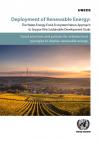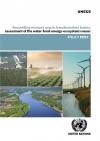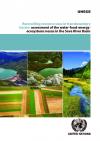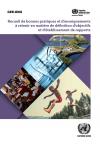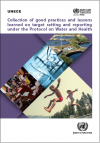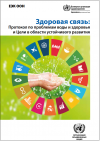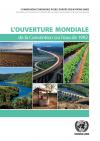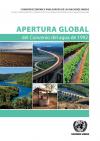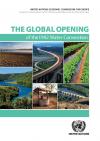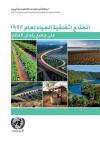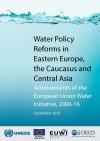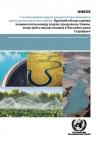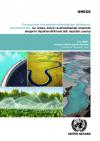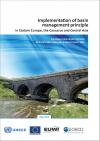Search
Displaying Results 121 - 140 of 537
- English
The 2030 Agenda for Sustainable Development includes Sustainable Development Goal (SDG) 7 on access to energy and the related targets set the ambition for increasing the share of renewable energies in the energy mix. Their achievement is closely linked water management (part of SDG 6 on water and
- English
This policy brief provides an introduction towards the different stages of and benefits from an assessment of the water-food-energy-ecosystems nexus, with a specific focus on resource use in transboundary basins. It summarizes the experience from the first three transboundary basins where a
- English
This policy brief synthesizes the main findings and recommendations from the nexus assessment of the Sava River Basin shared by Bosnia and Herzegovina, Croatia, Montenegro, Serbia and Slovenia which was carried out from 2014 to 2016 in the framework of the UNECE Water Convention’s Programme of Work
- English
Coordination between the water, energy, food and environment sectors is fraught with difficulties at the national level and the complexity increases substantially in transboundary basins. The “nexus approach” to managing interlinked resources has emerged as a way to enhance water, energy and food
- English
Coordination between the water, energy, food and environment sectors is fraught with difficulties at the national level and the complexity increases substantially in transboundary basins. The “nexus approach” to managing interlinked resources has emerged as a way to enhance water, energy and food
- Français
The objective of the Collection of good practices and lessons learned on target setting and reporting under the Protocol on Water and Health is to provide concrete advice to countries planning to embark on the process of setting, revising or implementing targets, and reporting on the progress
- English
The objective of the Collection of good practices and lessons learned on target setting and reporting under the Protocol on Water and Health is to provide concrete advice to countries planning to embark on the process of setting, revising or implementing targets, and reporting on the progress
- Pусский
The Guidance Note on the development of action plans aims to help countries in translating the priorities identified through the self-assessment into actions. Specific Equitable Access Action Plans are needed to guide country (or sub-national entity) efforts to achieve equitable access to water
- Français
The Guidance Note on the development of action plans aims to help countries in translating the priorities identified through the self-assessment into actions. Specific Equitable Access Action Plans are needed to guide country (or sub-national entity) efforts to achieve equitable access to water
- English
The Guidance Note on the development of action plans aims to help countries in translating the priorities identified through the self-assessment into actions. Specific Equitable Access Action Plans are needed to guide country (or sub-national entity) efforts to achieve equitable access to water
- Pусский
Water, sanitation and health are at the core of the 2030 Agenda for Sustainable Development.The 1999 Protocol on Water and Health is a powerful tool to promote and operationalize the achievement of the 2030 Agenda and its Sustainable Development Goals. With its strong integrated and
- English
Water, sanitation and health are at the core of the 2030 Agenda for Sustainable Development.The 1999 Protocol on Water and Health is a powerful tool to promote and operationalize the achievement of the 2030 Agenda and its Sustainable Development Goals. With its strong integrated and
- Français
La Convention sur la protection et l’utilisation des cours d’eau transfrontières et des lacs internationaux (Convention sur l’eau) a été adoptée en 1992 et est entrée en vigueur en 1996. Elle rassemble presque tous les pays partageant des eaux transfrontières dans la région paneuropéenne et devrait
- Español
El Convenio sobre la protección y utilización de los cursos de agua transfronterizos y de los lagos internacionales (Convenio del Agua) fue adoptado en 1992 y entró en vigor en 1996. Reúne casi todos los países que compar- ten aguas transfronterizas en la región paneuropea y se espera que alcance
- English
The Convention on the Protection and Use of Transboundary Watercourses and International Lakes (Water Convention) was adopted in 1992 and entered into force in 1996. It brings together almost all countries sharing transboundary waters in the pan-European region, and is expected to achieve broader
- العربية
The Convention on the Protection and Use of Transboundary Watercourses and International Lakes (Water Convention) was adopted in 1992 and entered into force in 1996. It brings together almost all countries sharing transboundary waters in the pan-European region, and is expected to achieve broader
- English
The brochure highlights the main outcomes of the EU Water Initiative (EUWI) contributions in the EECCA countries. Section 2 highlights specific achievements at a country level
in the context of national policy dialogues facilitated by the OECD and UNECE. Section 3 focuses on water diplomacy,
- English
Coordination between the water, energy, food and environment sectors is fraught with difficulties at the national level and the complexity increases substantially in
- English
This publication contains the results of the assessment of the water-food-energy-ecosystems nexus ─ essentially of intersectoral links, trade-offs and benefits ─ in the Alazani/Ganykh River Basin, shared by Azerbaijan and Georgia in the Caucasus, that has been carried out in the framework of the
- English
The purpose of this report is to provide an overview of implementation of the river basin planning principle in the countries of Eastern Europe, the Caucasus and Central Asia. It is a follow-up to a benchmarking study by UNECE and OECD from early 2014, where the overall status with regard to


